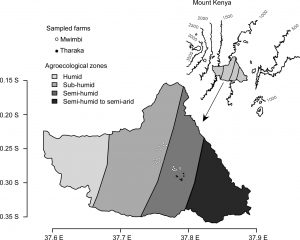l’article du mois – mai 2014
 Social Process of Adaptation to Environmental Changes: How Eastern African Societies Intervene between Crops and Climate
Social Process of Adaptation to Environmental Changes: How Eastern African Societies Intervene between Crops and Climate
Par Caroline Mwongera, Joseph Boyard-Micheau, Christian Baron, and Christian Leclerc
Weather, Climate, and Society, doi: 10.1175/WCAS-D-13-00034.1
Cet article fait également l’objet d’un « research highlights » dans NATURE CLIMATE CHANGE | VOL 4 | MAY 2014 | www.nature.com/natureclimatechange
Studies on climate change can only be conducted on a long-time scale, and observing how societies adapt their sowing practices to climate variability is challenging and costly. As an alternative, a space-and-time substitution design was used, changes in space corresponding to that induced in time by environmental change. On the eastern slope of Mount Kenya, the Tharaka community originating from the lowlands (750 m) moved up to the midlands (950 m) with their lowland adapted resources whereas the Mwimbi originating from wetter upland (1100 m) moved down to midlands with their highland adapted genetic resources. A weather station was installed at 950 m and 1100 m, and a GLM logistic model used to analyse the probability of sowing failure as a function of the length of dry spells after sowing. A total of 1691 plots in 40 surveyed farms were surveyed to compare Mwimbi and Tharaka during two years and four growing seasons, controlling crops and altitude. Although seed sowing practices were similar in both communities, the relative risk of sowing failure was 3.3 times more for Mwimbi than for Tharaka during the Short Rains, and 1.5 times more during the Long Rains. This difference can be explained by within-community seed exchanges, as Tharaka seeds, originally from the lowlands, are adapted to drier conditions, whereas Mwimbi seeds are adapted to wetter conditions. Our findings suggest an impact of historical and social factors on the mitigation of sowing failure risk. Thus, they must be considered as an integral part of the adaptation process to climate variability and change.
- extrait:
- lien_externe:
- kc_data:
- a:8:{i:0;s:0:"";s:4:"mode";s:0:"";s:3:"css";s:0:"";s:9:"max_width";s:0:"";s:7:"classes";s:0:"";s:9:"thumbnail";s:0:"";s:9:"collapsed";s:0:"";s:9:"optimized";s:0:"";}
- kc_raw_content:
 Social Process of Adaptation to Environmental Changes: How Eastern African Societies Intervene between Crops and Climate
Social Process of Adaptation to Environmental Changes: How Eastern African Societies Intervene between Crops and Climate
Par Caroline Mwongera, Joseph Boyard-Micheau, Christian Baron, and Christian LeclercWeather, Climate, and Society, doi: 10.1175/WCAS-D-13-00034.1
Cet article fait également l'objet d'un "research highlights" dans NATURE CLIMATE CHANGE | VOL 4 | MAY 2014 | www.nature.com/natureclimatechange
Studies on climate change can only be conducted on a long-time scale, and observing how societies adapt their sowing practices to climate variability is challenging and costly. As an alternative, a space-and-time substitution design was used, changes in space corresponding to that induced in time by environmental change. On the eastern slope of Mount Kenya, the Tharaka community originating from the lowlands (750 m) moved up to the midlands (950 m) with their lowland adapted resources whereas the Mwimbi originating from wetter upland (1100 m) moved down to midlands with their highland adapted genetic resources. A weather station was installed at 950 m and 1100 m, and a GLM logistic model used to analyse the probability of sowing failure as a function of the length of dry spells after sowing. A total of 1691 plots in 40 surveyed farms were surveyed to compare Mwimbi and Tharaka during two years and four growing seasons, controlling crops and altitude. Although seed sowing practices were similar in both communities, the relative risk of sowing failure was 3.3 times more for Mwimbi than for Tharaka during the Short Rains, and 1.5 times more during the Long Rains. This difference can be explained by within-community seed exchanges, as Tharaka seeds, originally from the lowlands, are adapted to drier conditions, whereas Mwimbi seeds are adapted to wetter conditions. Our findings suggest an impact of historical and social factors on the mitigation of sowing failure risk. Thus, they must be considered as an integral part of the adaptation process to climate variability and change.
